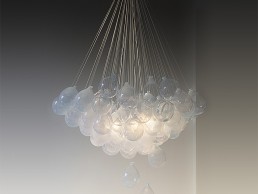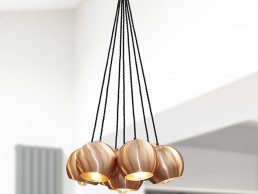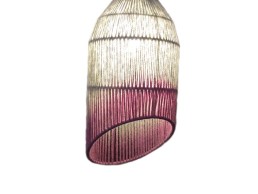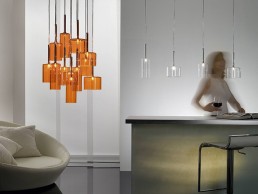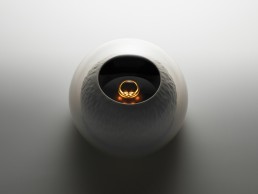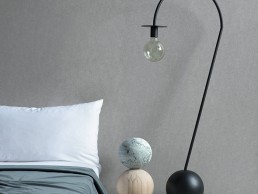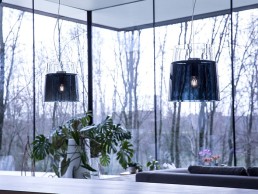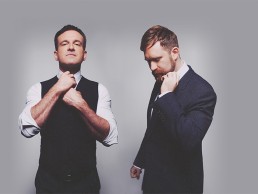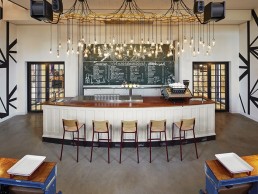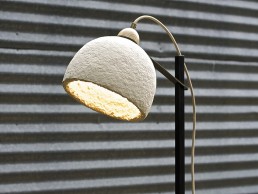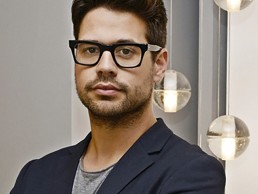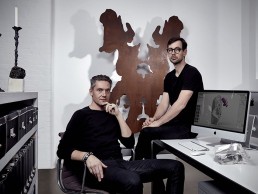Matteo Gonet Balloons
Matteo Gonet’s Balloons chandeliers are a classic in its collection. They represent the choreographically expression of a life-giving breath, of the free-thinker. The Balloons can be combined in a playful way to form a highly decorative object, while their opaline tint confers them delicacy in their nuances.
Industville Globe
The Globe collection is Industville’s newest edition to its range released exclusively at 100% Design. The combination of a sleek component design and high quality materials presents the new Globe pendant lights as a further illustration of Industville’s growing collection of light that can be tailored to any design brief.
Janie Knitted Textiles Seed
British wool has become the core material used by Jane Withers in her latest lighting collection Grain. Building on the success of last years’ Strand dip-dyed lights in 100% Merino wool, the new range, including Seed, features pared down contemporary shapes with Portland wool knitted on hand flat knitting machines.
www.janieknittedtextiles.co.uk
Axo Light Spillray
Axo Light’s Spillray features multi-faceted cups of light as an elegant and eclectic collection where all potential combinations create delicate fluid movements and intricate nuances of light. Spillray is available in various versions, while the diffusers are made of glass and proposed in three sizes with a choice of five colours.
Tangent Kihou
Designed by Tangent and Vezzini & Chen Kihou sees air bubbles, illuminated by LEDs, rise through a clear viscous liquid and break a dark silicone oil surface. The rhythm of bubbles, organic motion of the viscous liquid and contrast between golden light and the dark surface breathe life into this unconventionally fluid lighting experience.
Friends & Founders La Lampe
La Lampe lighting series from Danish design brand Friends & Founders provides lighting for floor, ceiling and wall. Together the collection offers clean, geometric shapes designed to be layered and viewed from different perspectives. The thin silhouettes produce a balancing act of both bold design and subtle lighting.
Prandina opens new flagship store
(Italy) - Prandina open new flagship store in company home town Bassano del Grappa.
The new space aims to become a new landmark for both customers and professionals that are looking for lighting products that communicate a defined and recognisable identity, breaking with current styles and short-term trends. An opening event was held on November 5, 6-8pm.
One of Prandina's latest product collections is Vestale, a blown glass collection with a new fumé finish. Vestale creates a coloured transparent effect that matches perfectly with its crystal lower or upper parts.
Prandina's Teodora and Gong Mini pendant lights have also been specified for the new five-star Mykonian K Hotel in Mykonos, Greece by Galal Mahmoud Architects. The light blue pastel colour of Teodora and the vibrant blue lagoon finish of Gong Mini marry with the characteristic Greek surroundings creating a cool and relaxing environment.
Uxus
UXUS goes beyond the obvious, focuses on the experience and concentrates on creating an emotional connection. A design agency that approaches each project individually, taking into consideration what the consumer’s emotional relationship with the brand and store will be, the end result is retail environments with ambience, mood and a somewhat theatrical feel.
Founded in Amsterdam, Netherlands, by George Anthony Gottl and Oliver John Palmer Michell, UXUS aims to create universal work that can be interpreted in different ways and different cultures. “We’re about creating desire for brands by designing spaces and experiences that in turn create lasting memories for consumers,” Gottl tells darc. “This ‘desire’ generation is very important because at the end of the day that’s what we do. I use the white shirt metaphor all the time… Say you need a white shirt, which one are you going to buy and why? Sometimes you might go to H&M because you’re price and style sensitive then sometimes you might go to a designer because you want something that feels unique and individual. Others might go to a second hand store because there’s a hip, bohemian attitude that they want to aspire to… The motivation behind the purchase is what drives the design behind a space and project.”
Gottl’s background in fashion (a degree in fashion from Parsons School of Design, New York, and time spent as Creative Director for apparel at Nike) combined with Michell’s background in architecture (having studied at the Bartlett School of Architecture followed by a stint with Rem Koolhass and then Paul Davis Architects), form an almost perfect blend that is portrayed through UXUS.
“I have a very in-depth knowledge of retail and how it works in terms of presentation,” says Gottl. “This has really helped propel our business forward as we apply a lot of the presentation techniques that you would in retail and visual merchandising, to the work we do. And that’s at every level, including restaurants and hotels, because in a lot of ways you visually merchandise food and hospitality spaces. There’s a big hunger in the market for emotionally engaging presentation.”
“My time with Paul Davis gave me a different perspective on what can be done in retail and I think this idea of creating consumer experiences was something that really interested me from very early on,” adds Michell. “Even working with Koolhass, there was a lot of emphasis on how you create the concept and then bring it to life. I like the idea of the theatre being involved in a retail or restaurant space and all the things you can do to activate the senses, as opposed to just creating a beautiful thing to admire. So you have to look at the scent, the temperature, sound and so on... It’s very exciting and I think retail and f&b really allow you to play in those areas. The idea of theatricality really comes into its own in a consumer led experience.”
And in terms of creating these theatrics, for Gottl, lighting is: “90% of the game… What I always say is, you could have a simple cardboard box – merchandise it nicely and put terrific lighting on it and you have a store.”
Michell continues: “It’s what creates the theatre, the ambience, the mood and of course, since lighting has become so much more sophisticated, you can really transform a space in an easy ‘flick of a switch’ kind of way and make it evolve through the day, through the year for different occasions. That is what makes retail theatre so much more possible. A lot of people talk about the idea of technology and digital being a big driver for experience, but the reality is lighting plays a much bigger role.”
“The technology that’s been incorporated in lighting is what’s actually making the breakthroughs in terms of bringing more to spaces,” continues Gottl, “It’s the technology that creates new effects - as a result, lighting is even more important than it has been in the past.
“If you go back to the 50s and look at the early department stores they were lit in a very functional way. Fluorescent tubes were at the forefront of technology at that time and lighting was very flat, very even and bright.
“Now, it’s not necessarily about where you can see yourself beautifully in the mirror – it’s more about the mood of the brand being reflected in the ambience and atmosphere of the store… Ninety percent of this comes from how you light the space.”
For the design duo, the area of lighting is still somewhat of a mystery to many of its clients as Gottl explains further: “I’m not technically versed in lighting so it can be really difficult to talk about lighting and what you want to achieve with it, in a way that can be understood by your client. Lighting is so intangible – I mean if you start talking about lux levels and so on, you have to think, what does that even mean to someone?”
“Then when you look at the relativity of what a colour temperature is, the perception in one culture that a certain colour temperature is desirable versus another one can be really different,” adds Michell. “You’ll find there are real differences when discussing with clients what the appropriate colour is. This varies again when looking at different sectors, different price levels and so on… There are no set rules about what should or shouldn’t be done.”
“Every brand should have signature lighting,” says Gottl. “Take Abercrombie when it first opened its doors… Love it or hate it, it’s a great example of lighting at its most powerful. They made a statement about how the store was going to be, it was lit in a way that was so theatrical you could have been in a burlesque theatre! It was dramatic and sexy.”
“Compare this with Dover Street Market,” adds Michell. “It has taken much more of a gallery approach to its lighting, producing an even light that allows the installations to take centre stage. They’re all equally lit and have the same starting point.”
Such is the importance of lighting to the way in which UXUS designs, that the studio will work with lighting designers as often as it can, encouraging its clients to involve them in the project. “It’s such a crucial part of the design process and the end results,” says Michell. “Most clients are quite open to it but sometimes there are certain pressures, and discussions are had as to why a lighting supplier can’t do the same job… This is where we have to educate our clients on what it is a lighting designer does and how they can make such a difference to the project.”
According to Gottl and Michell, one of the benefits of involving a lighting designer on projects comes down to impartiality – picking the very best products for what they are trying to achieve. As well as this, it is about showing their clients how good lighting can create a big difference to the atmosphere and push towards something extraordinary.
“For us, a really good lighting designer understands what the brand is trying to achieve and works towards creating signature lighting for that brand,” says Gottl. “It’s not about a personal vision, it is about personal knowledge and capabilities – the lighting designer needs to be a neutral advocate, but more importantly they need to try to work towards the message the brand is trying to express.”
Having worked with the likes of dpa lighting consultants on various projects, one UXUS project that particularly stands out for its strong lighting elements is Qela, a high end retail project in Doha. A couture clothing and jewellery store, here UXUS had the challenge of creating a space that was mostly a gallery, but happened to have retail within it. “The entire store was designed to be very flexible,” says Michell. “All the fixtures were floor based as opposed to wall based and we had to be able to change it all very quickly and easily. All the lighting used in that space was state-of-the-art and a lot of atmospheric lighting was brought in with different settings, allowing numerous scenes to be created for various events – whether an art event or private showing. “The lighting could be dramatically different and transform the space,” says Michell. “When it came to the jewellery on show it was very important to get the right light to show off the colour of the gems and bring out the sparkle in the diamonds – this is very specialist knowhow and as such dpa lighting recommended using fiber optics that were adjustable. Lots of different techniques were used to achieve something that was flexible and created the desired result – very high end, theatrical and exciting lighting effects.”
While traditionally a retail environment might look to architectural lighting to showcase it’s goods, according to UXUS as more and more retailers are moving towards the world of lifestyle and creating spaces that are more domestic, decorative lighting has become increasingly important. “It’s a direct way of creating an atmosphere, whether that’s through a suspended light or a floor lamp,” says Michell. “Just as it does in hospitality and department stores… You see it in some of the fashion retail that we do – you can transform a space very easily and it brings another dimension that’s not your expected retail shell. It makes the whole experience more human, approachable and creates a lot of drama through potentially, just one fixture.”
Looking ahead, while it may seem that the duo and their team of 100 at UXUS have achieved it all, for Gottl, similar to living in Amsterdam, “it’s like pedalling a bike, you never stop”, with a few department stores in the Middle East due for completion in the next couple of years and a couple of top secret pitches won. “These are some of our biggest projects to date so it’s really exciting,” says Gottl. “We’re also trying to get more involved in hospitality as this is an area we’ve always loved working in.”
And as the technology behind lighting continues to evolve, this can only work to strengthen the duo’s design process, with Michell telling darc: “Working with light adds the magic to whatever you’re creating from a space point of view. Technology in lighting is allowing more and more exciting opportunities – one of my biggest gripes in the past has been around the use of LED. We like to use it where we can but previously, trying to create the same kind of effects you can with halogen lamps has been difficult - thankfully I can see the developments coming out. Conversely, there’s new lighting technologies coming out that allow you to do things you’ve never done before, it opens up a whole new palatte of possibilities… It’s an exciting time for lighting.”
And for Gottl: “I think lighting in itself is a form of decoration. It’s a fundamental ingredient. Someone is only a star if they have a spotlight on them.”
Generator Amsterdam, The Netherlands
Canadian firm DesignAgency brought the history of the University of Amsterdam into the modern day traveller's experience with the Generator Amsterdam hostel.
A gateway to Amsterdam’s Oosterpark in the Netherlands, Generator Amsterdam is an urban design-led hostel in the Oost neighbourhood, a thriving destination for art, fashion and independent business.
With over ten destinations worldwide, Generator’s global design partner DesignAgency collaborated with local architects IDEA Ontwerp on this project to both convert and restore a former health sciences building and zoological museum, and breathe new life into the 100 year old brick structure, establishing the most striking Generator to date.
DesignAgency Partner Anwar Mekhayech told darc: “With each new addition to the Generator portfolio we create something with an intriguing design. We want to create a memorable journey for guests travelling in Europe and staying at multiple Generators – city to city.”
The 168-room hostel follows Generator’s concept of design-focused hospitality with an array of spaces that encourage social interaction, while the building’s original, heritage-designated spaces have been preserved and overlaid with contemporary twists. The building was initially home to the laboratory for Health Studies of the University of Amsterdam, which stood as a cornerstone of the overall design in respecting and valuing the original features of the building and its former occupation. The interior mixes the history and charm of the building with references to Dutch folk culture and iconic design, as well as playful lighting synonymous with the Generator brand.
A partnership with various Dutch artists and designers drove the project to new creative heights; DesignAgency determined the concept for the lighting, working with architects IDEA Ontwerp and lighting consultants ARTEC3. The selection and placement of many lighting fixtures was developed in close collaboration with Blom & Blom, Dutch brothers who share a passion for restoring forgotten treasures. Martijn and Kamiel Blom collected and restored hundreds of light fixtures, many from abandoned factories in East Germany, playing on the building’s new-old duality.
Mekhayech commented on the collaboration: “We discovered Blom & Blom in 2014 while sourcing furniture and getting to know the design scene in Amsterdam. Their passion for finding and restoring old lighting was the perfect marriage for Generator Amsterdam.”
The Dutch brothers’ work is seen all over the hostel, notably in the Laboratory light feature in the auditorium consisting of 70 laboratory glass beakers. Part of this glassware was actually used by the students of the University of Amsterdam and recovered from the building’s basement, while various repurposed pendants and wall sconces feature elsewhere in the hostel’s typical rooms and luxury suites. The hostel’s basement also features a bar housing a number of unique Blom & Blom fixtures, joined by a sighting of Holloways of Ludlow’s Stirrup floor lamp.
The Blom brothers expressed their enthusiasm for this project and the chemistry of all parties involved: “For us it was most appealing that this project was about giving a unique building a new function which respect to its past. It is a building with a story – a soul – in our hometown. This approach aligns perfectly with what we stand for: reviving undervalued objects to show their beauty again. When we met Anwar and IDEA Ontwerp, we knew this was going to be an interesting project.”
Determined to create something worthy of the city of Amsterdam, DesignAgency had a focus on the quirky and fun personality of prominent Dutch design. With the east end of Amsterdam blossoming as a creative hub with new concepts and places, it made the perfect home for Generator by allowing it to stay true to the DNA of the brand, while reviving the industrial and heritage nature of the building.
“The vision was to play off the heritage of the building as well as to collaborate as much as possible with local talent,” said Mekhayech. “We viewed each design element as a playful intervention in the building. We don’t have a signature style but in each project, we examine how to use design to bolster a client’s brand. And we’re most interested in projects that allow us to collaborate creatively and playfully while incorporating art and special lighting.”
The hostel’s art and lighting add to the sense of discovery at Generator Amsterdam, so whether a guest or a local enjoying the park, the venue can be felt as a gallery or museum, where one can wander through spaces and discover surprises.
“Blom & Blom’s provenance of each lighting fixture enhances that experience,” added Mekhayech. “The original building was very dark and ominous, so we wanted to open it up and infuse it with a new creative spirit.”
The lighting adds playfulness whilst remaining in line with what might have been there before. “Blom & Blom helped guide a lot of our thinking about the lighting – we tried to keep it simple, industrial and fitting to the building – which was very raw when we started this project: we love how Blom & Blom document the source of each fixture.”
Kamiel expanded on how they pay tribute to the history of the fixtures they restore: “Our products come together with a story behind them. With each purchase, we provide the client with a historical passport, a small booklet describing the origin and history of the lamp, or a museum-like sign with an image and text on its place of origin. For Generator Amsterdam, we placed the latter signage with the lighting fixtures throughout the building.”
“This was a simultaneous celebration of both history and contemporary spirit,” added Mekhayech.
All the original lighting fixtures that Blom & Blom provided for Generator Hostel originate from abandoned factories in former Easy Germany. In the last few years, the pair have strolled through abandoned factories, old laboratories and deserted military complexes to gather a large collection of original lighting fixtures, with their pieces restored and redesigned at their studio and workshop in Amsterdam.
The Dutch brothers are very particular in their selection of lighting fixtures, and find the East German lamps to be of a higher standard than lamps from other countries, with the Bauhaus movement of the 1930’s influencing many of them. “Their designs were signified by their simplicity and pureness with ‘Form follows function’ as their mantra – a design style that can also be appreciated today,” said Martijn.
Besides their collection of restored and redesigned fixtures, Blom & Blom also designed custom lighting features for Generator, which remain in line with the values of their original lights as characterised by the use of pure and often repurposed materials. These custom signature lighting statements include the triple neon keys greeting guests over the reception, which are a tongue-in-cheek reference to both Amsterdam’s coat of arms and its red light district.
Entering through the hostel’s group entrance, which leads into the ground floor café lounge, guests are greeted with Muuto’s casual Unfold pendants in black, designed by Form Us With Love design studio. Moving through to the hostel’s ground floor café lounge, Karman Italia’s Metra fixture features above the communal table and in the back coffee corner, adding a dash of colour to continue the hostel’s playful theme. This area also offers seating within house-shaped frames illuminated by Moooi’s Paper chandelier and ines.artdesign’s Nebulite pendant. Anglepoise’s Giant 1227 floor lamps also add a gentle sense of vibrancy and imagination to these spaces with their oversized forms.
In the suites, Anglepoise’s Original 1227 bedside wall and desk lamps have been incorporated, with Merci Merci’s Angled Wall lights illuminating the shared bathrooms that exist within the bedrooms.
In dealing with a space with such historic character, there are natural challenges that come with wanting to bring its heritage into the modern day. The building’s history guided many of the decisions, predetermining what they were able to do in many situations. IDEA Ontwerp worked closely with the planning department to ensure the heritage nature of the building could be maintained while adding two new glass levels to the top part of the building, giving DesignAgency the space they needed to have enough rooms to make the project viable. The auditorium with a modern cove lit ceiling, and library, featuring Resident’s Cross pendant, were sanctioned off as prime heritage rooms, as was the exterior. DesignAgency worked to find solutions to upgrade them that worked within the parameters and presented all ideas for approvals.
Responsible for the entire interior design, DesignAgency’s working relationship with Blom & Blom was one of creativity and cooperation. Martijn commented: “DesignAgency allowed us a lot of creative freedom, which was great. They adopted many of our suggestions and by presenting various ideas back and forth, I think this led to a design that captured the overall interior concept, and resulted in some great lighting features.”
Mekhayech commented on the challenges the team overcame to achieve the final vision: “In the lobby, we left the stained glass windows at the park entrance foyer and exposed some amazing internal brickwork around the reception. In the auditorium we were able to add a structural mezzanine that connects the auditorium with the library. I love how the mural by Graphic Surgery accentuates the contrast between old and new. We left the library almost completely in its original form, but with some fun new additions. The original handrail and green railings in the main two stairwells, which house Alexander and Pearl’s Area Black and White Swivel light, are my favourite features of the original buildings.”
With the final outcome of Generator Amsterdam standing remarkably close to the original vision, the project is Mekhayech’s favourite Generator project to date, telling darc. “I think it’s a very mature project that really balances a lot of elements that make for a great hotel and an even more unique hostel. Artistically, it is very expressive and the intervention of the concept into the old building works perfectly for the Generator brand. It really addresses the urban context of the property’s city side, and the true Dutch nature of its park side.”
With the playful composition of laboratory glass beakers illuminating the auditorium, and a labyrinth of pipes, values and lights crawling behind the boiler room bar, down to the Anglepoise bedside lighting, every detail of this project emphasises the building’s history. It is a combination of restoration and redesign, reflected through DesignAgency’s scheme and Blom & Blom’s dedicated and passionate work. In its new and enlightened form, the University of Amsterdam’s experimental and scientific history will resonate in the eager and enthusiastic hearts of design loving guests of the Generator Amsterdam hostel, as they return home with stories of how the building’s past twisted its way into to their modern day travelling experience.
Danielle Trofe MushLume
Working at the intersection of design, technology and science, Brooklyn-based design studio Danielle Trofe Design is evolving the definition of designer lighting one MushLume at a time.
In harnessing innovative technologies and material sciences to create functional and accessible design, Danielle Trofe’s studio in New York, USA, aims to encourage a departure from conventional materials and production techniques in search of long-term, sustainable solutions in design.
Born and raised in Austin, Texas, Trofe lived out in the country growing up surrounded by horses and chickens. “I was outside every single day as a child,” she tells darc. “I believe I owe much of my affinity for and derived inspiration from nature and my value of it is deeply embedded in my childhood.”
Trofe’s educational path into the design field was an unconventional one, receiving a Bachelor’s degree in marketing and entrepreneurship from Florida State University and then switching gears to achieve a Master’s degree from the Florence Design Academy in Italy. It wasn’t until the budding designer was introduced to 3D modelling software that she realised her true calling in product design. “I’m currently studying for a Master’s degree in biomimicry from Arizona State University with an aim to incorporate sustainability at an even deeper level in my practice. Biomimicry is looking at nature’s form, function and ecosystems and consciously emulating these evolved strategies into human design.”
While scoping out a project at materials innovation library Material ConneXion in Manhattan, Trofe came across something called Mushroom Materials, developed and produced by biomaterials company Ecovative, which grows sustainable products. “This fascinating mushroom material combines mushroom mycelium – the root structure of mushrooms – with agricultural waste – corn stalks and seed husks – to create a natural, sustainable and biodegradable material that is grown, not manufactured,” says Trofe. “I knew immediately that I wanted to work with it and discover new applications within the furniture and lighting industry.”
Mushroom mycelium speaks to the three pillars at the core of Trofe’s studio – science, technology and design – while also taking into consideration the full lifecycle of the product. “You’re starting with a waste product from the agricultural industry, upcycling it and combining it with mycelium, which is a rapidly renewable resource,” continues Trofe. “Instead of adding excessive water, heat and energy used during the ‘manufacturing’ process, you’re using only the power of nature to grow the product. Finally, at the end of its life, the material can safely biodegrade, adding nutrients back to the soil rather than pollutants. That is real sustainability!”
The gentle and nurturing impact of this fascinating material is reflected in its interaction with light when used to create decorative lighting. Trofe has primarily developed a line of lighting using the mushroom material, with explorations in planters and other decorative interior objects under development for several years. “The MushLume lighting collection creates directional lighting due to the soft, non-translucent properties of the mycelium material. The diffusing and softening, especially of harsh LED light admittance, is quite enchanting. The mycelium’s natural white hue combined with the organic structure of the agricultural substrate creates a textural journey of flowing light.”
In order to capture such a gentle luminosity and really harness this innovative material, Trofe has found herself experimenting with somewhat unconventional methodologies in industrial design. Yet the evolution of what the young designer has created as a retail product line depicts a more structured process. The MushLume Cup light series was developed this past year in order to create a modular version of a hanging, table and floor lamp that uses one universal shade, no-tool assembly and ships flat. The universal shade was first prototyped by 3D printing moulds in which to grow the shades. After several modifications and iterations, parts were altered or eliminated and a paired down, affordable and an eloquent series emerged.
Yet even with its successful development and enchanting luminosity, creating lights out of mushrooms comes with as many difficulties as one might imagine. “You’re working with a living organism, so there are a lot of challenges that go along with the growing process,” explains Trofe. “Creating proper growing conditions, eliminating sources of contamination and developing strategies that best meet the needs of each size and volume of lampshade are just a few trials when working with this material. As a designer, creating solutions along a set of parameters and solving for the unexpected can be considered normal skill sets; however designing for and with new material processes often requires a longer timeline of research and development in order to effectively evolve a prototype into a product that can be produced.”
Trofe’s studio is currently scaling production of the MushLume lighting collection to enable a greater retail and commercial reach. “I would ultimately like to see all the components be made either from mycelium-based materials or other natural material equivalents, thus elevating the product line to an even higher level of product sustainability. Ecovative has made some amazing advancements with their high-density line of mushroom material, Myco Board. I definitely see a future exploration of applications of this material within the interiors industry.”
With sustainability at the forefront of modern invention and design discourse, Trofe’s work with mycelium is a leader in its field. It goes hand in hand with the environmental implications of LEDs, and demonstrates the thoughtful and intelligent direction in which the decorative lighting industry is moving.
Lucio Longoni
With a varied wealth of experience across the retail sector, darc chats with Retail Buying and Wholesale Consultant Lucio Longoni to find out what, in this digital age, makes a store worth visiting.
BORN AND RAISED
I was born in Chester, UK, and always had an interest in interiors. When I left school, I studied 3D and spatial design, graphic, product, and exhibition design, as well as typical interior design and basic interior architecture. Within these subjects I was always pushing myself into the interior design side of things.
A WORKING MAN
And then I entered the world of work! I always wanted to work within the design industry in some capacity, so I started off in retail on a trainee management scheme in Chester. I eventually moved away from home to Edinburgh, still working within various lifestyle and interior brands and then eventually worked my way to London.
HEAD OVER HEAL’S
I worked for lifestyle brands White Company and Habitat before starting at Heal’s, where I did an internship at the head office one day a week for about five months. Soon enough, I started full time, working on the website as content coordinator, where I gained a solid grasp of brand and product knowledge within the lifestyle and design industry.
I then moved into a buying role and things carried on from there - I worked across nearly every category! I focussed on lighting, home accessories, Christmas, textiles, giftware, the list goes on.
After Heal’s I worked for Urban Outfitters for a season buying homeware for Europe, and then went to work for Skandium, before setting up my consultancy.
A KEEN EYE
Having an interest in interior design, you naturally become quite a perceptive person. You pick up on all the senses; the look, the smell, the feel, even the body language.
Working in retail management both in store and online for various brands has given me a completely different angle on the world of retail.
Working in store and seeing everything first hand at the beginning of my career really gave me a huge understanding of what the store experience should be like, how it should feel to consumers and how they should connect. That goes through from the product selection all the way through to the interior design and the lighting. It’s not just about the right products, nor just the right service and interiors. It’s about the complete package.
My background in e-commerce, which is indisputably important in the retail world these days, has really shown me that it’s all about the experience, both online and offline. With this omnichannel retailing, the two have to be in sync. You need to have a strong website and a strong retail store environment that provides an experience through the complete package of its interior design, product selection and customer service. Interior design runs through all channels, physical and digital.
THE RETAIL EXPERIENCE
With the emergence and continuing growth of online stores, the physical store is actually now becoming more important than ever. It’s no longer good enough to just have a beautiful interior, it now needs to have the wow-factor. A great way of doing this is by playing with lighting to enhance the mood of the store. Today we are seeing more and more retailers that are playing with lighting in terms of tones and expression, or stand out lighting installations that work to evoke something in the shopper. It needs to be an extra experience, a destination. It’s about more than just buying something, because we can do that online, so stores are now introducing small coffee bars and things like that, which opens up even more opportunities for different types of lighting that you might normally find in a café, in a shop instead! This all adds to the customer’s understanding of what it means to be part of that brand’s customer base.
WHO DOES IT BEST
The COS store on Regent Street, London, featuring Michael Anastassiades’ Mobile chandelier in the staircase is a great example of a retailer using decorative lighting as an integral element of the retail experience. It’s a beautiful store selling products to the affordable to mid-market consumer, so the relationship between the cost of the fit out and the cost of the stock is completely out of scale, which I find really interesting.
I think what we’re seeing here is how the lighting affects the value of the products being sold. The chandelier provides the customer with more of an experience, which gives them more of a reason to want to part with their money.
Lee Broom’s Crystal Bulb and Decanterlight collections in the Wonder Room at Selfridges on Oxford Street, London, is another beautiful example of what lighting can offer in retail spaces. It features over 300 pendants to create a cascade of lights, which wrap around the central circulation space, creating a sparkling focal point for the department store’s most prestigious space. This installation by Lee Broom as a British designer is really in harmony with Selfridges as one of London’s most iconic stores. Also as an international destination store, I think it goes a long way to immerse its consumers in a unique experience.
One more, although I might be biased, is Bocci’s 14 Series chandelier with 64 arms in Heal’s, London. The grand spiral staircase was built in 1916 and previously had a chandelier hanging down its centre until the 1990’s, when it was left empty. This 64 arm installation was unveiled during London Design Festival 2013 and really transformed the store. It brought back a sense of drama and theatre, providing a focal point at the back of the lighting department to entice customers up to the floors above.
ARCHITECTURAL MEETS DECORATIVE
I think decorative lighting is catching up with architectural lighting, which has become much more considered in the last 20 years or so. I think the combination and harmony of the two now is essential. Stores are lit in a way that flatters the consumer, flatters the shape of the products and items that a consumer may be perusing - bad lighting does not sell. Lighting is a great way to create this customer experience and I think that’s partly because you can include it in a store layout without compromising on any shelf or selling space. It’s fine to invest in a sofa, but you’re loosing sale space, whereas lighting can sit above and still impress without actually taking away from shop floor space.
ALL THE RAGE
And these customer experiences are manifesting themselves in different ways at the minute, two in particular that contradict each other. Minimalism is clearly a trend at the minute. We’re seeing a lot of paired back, simple stores with soft angular designs like Michael Anastassiades’ work in COS. It’s a very sleek look.
Then at the other end of the spectrum, we have the eclectic, almost ethnic feel, which has a huge following, with designs coming in from different cultures. I saw that at London Design Festival this year, with a broad selection of international design pavilions from around the world, including India. In the past it’s been hard to find modern designs in the mass market that tap into the heritage of India while still looking modern but I think that’s been achieved now.
KEEP IT ALIVE
I think purchasing is heading towards e-commerce, and that’s where it should go, but I would love to see retail spaces maintained. They won’t function as they did forty or fifty years ago, but I do hope they integrate themselves, and keep pushing the boundaries in order to keep people off their computers and mobile phones and into stores to treat this as a recreational activity, rather than just something to do online. Retailers need to keep it alive.
Fredrikson Stallard
For the first time in over 100 years, Swarovski has enlisted the skills of independent designers to create a new range of crystal components. In this exclusive interview, design duo Fredriskon Stallard describe the honour of creating the Glaciarium chandeliers.
Designed exclusively for Swarovski, Fredrikson Stallard presented their Glaciarium collection during this year’s London Design Festival.
Inspired by the mysterious appearance of crystal and its behaviour in its raw state, the new collection of objects includes a series of vases, bowls and candle-holders as well as four stunning chandeliers: Avalon, Helios, Superline and Voltaire, which sit alongside and a series of crystal chandelier components for independent designers to work with.
While Patrick Fredrikson and Ian Stallard have collaborated on numerous projects with Swarovski that span a decade, this is the first time designers from outside the ‘Swarovski family’ have been asked to design the individual crystal components, and as such the project has been a great honour for the design duo, as they explained to darc: “The outside world won’t realise what a big deal this is,” says Fredrikson. “Swarovski have, over the years, asked fashion and jewellery designers to reinterpret their work and more recently, a broader range of creatives, but this is the first time they’ve let anybody get to the heart of the company and create the shapes of the crystals themselves. It’s a huge honour to be asked to do this and so we had to do something that took the crystal components into the next century – it wasn’t enough for us to just create a new shape.
“It’s great to design something that then becomes a building block for other designers – it’s like creating words for someone to create a story with. That for us, is just as exciting as developing the chandeliers ourselves.”
“It’s going to be really interesting to see what other designers will do with the components,” adds Stallard. “Even the chandeliers we’ve created are modular in the way that interior designers and architects can work with them.
“This is a new chapter for Swarovski and one of the challenges was to be able to marry the former components with these new ones. We had to create components that would create all sorts of chandeliers for all sorts of lighting applications.”
“The new shape of the components is very soft and curvaceous in comparison to the harsh, straight forward cut we’re used to seeing from Swarovski and we had to get the right balance between the two,” continues Fredrikson. “The reason we use crystals in the first place is because we want that extra sparkle, extra explosion of light and refraction and each one of the components needed to keep that element.”
Having first met Nadja Swarovski ten years ago when asked to propose a piece for Swarovski Crystal Palace, Fredrikson Stallard has built up a relationship that is more like a working family where honesty and a creative vision go hand in hand. “Nadja is a real visionary,” says Stallard. “Swarovski is amazing in the way it works, they never say something can’t be done, we’ve not hit that wall with them yet and that’s really amazing. There is this entire team that has a real spirit of making something better, asking how something can be pushed forward.”
“We’ve got to a point where we feel comfortable presenting ideas to them and vice versa,” adds Fredrikson. “Then we try to find the right time and place to do something about it. I think Swarovski also appreciate our honesty, we have quite a harsh editing process within the studio… just because you can do something, doesn’t mean you should.
“We try to push the material but also understand it at the same time; crystal is a very tricky material because it can be considered kitsch in some ways, it’s about the bling and the sparkle… Whereas for us, it’s much more about its inherent qualities, it’s about the heart of the material and we never use any materials as a decoration or because we have to, it’s more about the material becoming intrinsic to the piece. All of these elements have made our relationship with Swarovski very symbolic.”
As designers, for Fredrikson Stallard it’s important that they don’t deliberately constrain themselves. Untraditional in their process, their aim is to create something that the world is a better place for having rather than producing something that really, when you look at it closer, is unnecessary.
“There are some aspects of product design which are very much about creating something in a more simple way and it’s more about functionality, which is great,” says Fredrikson. “Then there’s what we do, which is at the complete other end of the scale – creating objects which we feel will enhance people’s lives… it’s the middle ground which we don’t really understand, where people generate more and more products that don’t necessarily do anything different – they just look slightly different or have added functions that aren’t really necessary.
“When we come to our own work we describe it as turning the volume up and down. We ask ourselves how creative we can be with a design object; for example you wouldn’t be able to furnish an entire house with our Species sofa, you’d go insane and as such we have other pieces that maybe don’t fit on the front cover of a magazine, but they’re much quieter in the space and create the canvas for the paint so to speak.”
Having both studied at St Martins College, London, which is where the Fredrikson Stallard story begins, both designers feel their different upbringings, experiences and influences have worked together to form a partnership that is quite unique. Born in Sweden, for Fredrikson design was always very imprinted in his life – Scandinavian design is not something you can avoid, running through everyday life in a very conscious way and it was almost this that pushed him towards London, with its floods of people moving in and out of the city, turning it into something quite amazing. “London spoils you,” he tells darc. “I’ve been here 22 years and it’s still the most amazing city on the planet to me. You have everything you need and want. I consider Swedish design as my heritage but then I moved on from that.”
“I think for me, coming from an English seaside town moving to London at the age of nineteen was fabulous,” says Stallard. “What had the biggest impact on me is the interdisciplinary nature of the city, particularly at St Martins where you had very creative people from different backgrounds studying different disciplines. You don’t feel like you’re being pigeonholed into a certain style of work.”
And when working with light?
“It’s difficult to say what lighting ‘should’ bring to a space,” continues Stallard. “There are some incredible lighting designers out there and we see it when we visit the homes of clients that are fine art collectors – their homes are always lit beautifully, but you never really know where the lighting is coming from.
“What we do is create objects that bring something special to a space, essentially sculptural objects that involve light. With Swarovski crystals it is all about light and reflections and refractions, movement and colour within the crystals, so you need to work with light, it’s essential and part of it. To me, working with light is like painting.”


